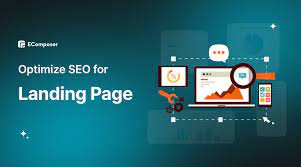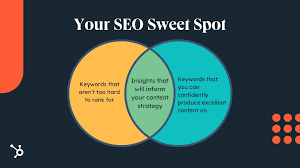Landing Page SEO: Optimizing Your Path to Online Success
In the world of online marketing, landing pages play a crucial role in driving conversions and achieving business goals. A well-optimized landing page can make all the difference between a successful campaign and a missed opportunity. That’s where landing page SEO comes into play.
What is Landing Page SEO?
Landing page SEO refers to the process of optimizing your landing pages to improve their visibility in search engine results. By implementing strategic SEO techniques, you can increase organic traffic, improve user experience, and ultimately boost your conversion rates.
Key Elements of Landing Page SEO:
- Relevant Keywords: Conduct thorough keyword research to identify the terms and phrases potential visitors are using to search for products or services similar to what you offer. Incorporate these keywords strategically into your landing page content, including headings, subheadings, meta tags, and image alt text.
- Compelling Meta Tags: Craft persuasive meta titles and descriptions that accurately reflect the content on your landing page while enticing users to click through from search engine results pages (SERPs). Make sure they include relevant keywords and provide a clear value proposition.
- Clear Call-to-Action (CTA): Every effective landing page should have a clear and compelling CTA that guides visitors towards taking the desired action. Whether it’s making a purchase, signing up for a newsletter, or downloading an e-book, your CTA should be prominently displayed and stand out visually.
- Engaging Content: High-quality content is essential for both user engagement and search engine rankings. Create informative, relevant, and valuable content that addresses the pain points of your target audience while incorporating relevant keywords naturally.
- Mobile Optimization: With an increasing number of people accessing the internet through mobile devices, optimizing your landing pages for mobile responsiveness is crucial. Ensure that your pages load quickly on mobile devices and are easy to navigate with clear calls-to-action.
- User Experience: A positive user experience is essential for both search engines and visitors. Optimize your landing pages for fast loading times, easy navigation, and a clean design. Make sure your content is scannable with clear headings, bullet points, and relevant visuals.
- Social Proof: Including social proof elements such as customer testimonials, reviews, or case studies can help build trust and credibility with your audience. Positive social signals can also indirectly impact search engine rankings.
- A/B Testing: Continuously test different variations of your landing pages to identify the most effective elements that drive conversions. Experiment with different headlines, CTAs, layouts, and visuals to optimize your page’s performance over time.
Remember that landing page SEO is an ongoing process that requires monitoring and adjustment. Regularly analyze key metrics such as bounce rate, time on page, and conversion rates to identify areas for improvement.
By implementing effective landing page SEO strategies, you can increase the visibility of your landing pages in search engine results and drive more qualified traffic to your website. Ultimately, this will lead to higher conversion rates and help you achieve your online marketing objectives.
5 Common Questions About Landing Page SEO Answered
- What is the difference between SEO and PPC landing page?
- How do I optimize my landing page for keywords?
- How do I optimize my landing page for SEO?
- How long should a SEO landing page be?
- Do landing pages impact SEO?
What is the difference between SEO and PPC landing page?
SEO and PPC landing pages serve different purposes and are designed to cater to specific marketing strategies. Here’s a breakdown of the key differences between the two:
SEO Landing Page:
Organic Traffic: SEO landing pages aim to attract organic traffic from search engine results pages (SERPs) by optimizing the page’s content, structure, and other elements. They rely on search engine algorithms to rank and display the page based on its relevance and quality.
Long-Term Results: SEO efforts take time to yield results as they involve improving website authority, optimizing content, and building backlinks. However, once a page ranks well organically, it can generate consistent traffic over an extended period without incurring additional costs.
Keyword Focus: SEO landing pages heavily rely on keyword research and optimization. The content is tailored to target specific keywords or search queries that align with the user’s intent. The goal is to provide valuable information that matches what users are searching for.
Content Depth: SEO landing pages often feature comprehensive content that addresses user queries in detail. They aim to provide in-depth information, answer questions, solve problems, or educate visitors about a particular topic or product.
Cost: While SEO itself does not have direct costs associated with it, it requires investments in time, resources, and expertise for keyword research, content creation, technical optimization, and ongoing maintenance.
PPC Landing Page:
Paid Traffic: PPC landing pages are designed specifically for paid advertising campaigns like Google Ads or social media ads. They appear when users click on paid ads displayed on search engine results or social media platforms.
Immediate Results: PPC campaigns generate almost instant results as soon as the ads go live and start driving traffic to the landing page. This makes them suitable for short-term promotions or time-sensitive offers.
Ad Copy Focus: PPC landing pages need concise yet compelling ad copy that grabs attention quickly since users are more likely to skim through the content. The focus is on highlighting unique selling points, benefits, and strong calls-to-action to encourage conversions.
Conversion Optimization: PPC landing pages prioritize conversion rate optimization (CRO) techniques to maximize the number of visitors who take the desired action, such as making a purchase or filling out a form. Visual elements, clear CTAs, and simplified forms are often used to streamline the conversion process.
Cost: PPC campaigns require a budget as you pay for each click generated by your ads. The cost per click (CPC) varies depending on factors like competition, industry, and ad quality score. The effectiveness of a PPC campaign relies on optimizing ad spend and monitoring ROI closely.
While both SEO and PPC landing pages aim to drive conversions, they differ in terms of traffic sources, timeframes for results, content approach, and associated costs. Businesses often utilize both strategies simultaneously to maximize their online presence and reach different segments of their target audience effectively.
How do I optimize my landing page for keywords?
Optimizing your landing page for keywords is crucial for improving its visibility in search engine results and attracting relevant organic traffic. Here are some steps to help you optimize your landing page effectively:
Conduct Keyword Research: Start by conducting thorough keyword research to identify the terms and phrases that your target audience is using to search for products or services similar to what you offer. Use keyword research tools like Google Keyword Planner, SEMrush, or Moz’s Keyword Explorer to find relevant keywords with a good search volume and moderate competition.
Choose Target Keywords: Select a primary keyword or key phrase that best represents the main focus of your landing page. This should be a term that accurately reflects the content and purpose of your page. Additionally, choose a few secondary keywords or related terms that support the primary keyword.
Strategic Placement: Once you have identified your target keywords, it’s important to strategically place them throughout your landing page:
– Page Title: Include your primary keyword in the title tag of your landing page. This is an important on-page SEO element that search engines consider when ranking pages.
– Headings and Subheadings: Incorporate relevant keywords naturally into headings (H1, H2, etc.) and subheadings on your landing page. This helps search engines understand the structure and content of your page.
– Content: Integrate target keywords into the body content of your landing page while ensuring it reads naturally and provides value to users. Avoid keyword stuffing, as it can negatively impact user experience and search engine rankings.
– Meta Description: Craft a compelling meta description that includes relevant keywords while enticing users to click through from search engine results pages (SERPs). Although meta descriptions don’t directly impact rankings, they can influence click-through rates.
– URL Structure: If possible, include target keywords in the URL of your landing page for better optimization. A clean and descriptive URL structure can improve user experience and search engine visibility.
Image Optimization: Optimize the images on your landing page by adding descriptive alt text that includes relevant keywords. This helps search engines understand the context of your images and can contribute to improved rankings.
Internal Linking: Incorporate internal links within your landing page content to other relevant pages on your website. This not only helps users navigate your site but also provides search engines with additional context and signals about the relevance of your landing page.
Monitor Performance: Regularly monitor the performance of your landing page using analytics tools like Google Analytics or other tracking software. Pay attention to metrics such as organic traffic, bounce rate, time on page, and conversion rates. This will help you identify areas for improvement and make data-driven optimizations over time.
Remember, keyword optimization is just one aspect of a well-optimized landing page. Providing valuable content, a clear call-to-action, and an excellent user experience are equally important for driving conversions and achieving success with your landing pages.
How do I optimize my landing page for SEO?
Optimizing your landing page for SEO involves several key steps. Here are some effective strategies to help you optimize your landing page and improve its visibility in search engine results:
- Conduct Keyword Research: Start by identifying relevant keywords that align with your landing page’s content and the intent of your target audience. Use keyword research tools to find popular search terms and incorporate them naturally into your page’s content, headings, meta tags, and image alt text.
- Create Unique and Engaging Content: Craft high-quality, informative, and engaging content that addresses the needs and pain points of your target audience. Ensure that your content is original, well-structured, and easy to read. Incorporate relevant keywords naturally throughout the content.
- Optimize Meta Tags: Write compelling meta titles and descriptions that accurately describe the content on your landing page while enticing users to click through from search engine results pages (SERPs). Include relevant keywords in these meta tags to improve their visibility in search results.
- Mobile-Friendly Design: With the increasing use of mobile devices, it’s crucial to optimize your landing page for mobile responsiveness. Ensure that your page loads quickly on mobile devices, has a responsive design that adapts to different screen sizes, and provides a seamless user experience.
- Clear Call-to-Action (CTA): Every effective landing page should have a clear and prominent call-to-action (CTA) that guides visitors towards taking the desired action. Make sure your CTA stands out visually, uses persuasive language, and is strategically placed on the page.
- Improve Page Load Speed: Page load speed is an important ranking factor for search engines as well as a crucial aspect of user experience. Optimize images, minimize code bloat, leverage browser caching, and use a reliable hosting service to ensure fast loading times for your landing page.
- Optimize Images: Use descriptive file names for images and include relevant alt text to help search engines understand what the images represent. Optimized images can improve your page’s visibility in image search results and enhance overall SEO.
- Internal and External Linking: Include internal links within your landing page to other relevant pages on your website. This helps search engines navigate and understand the structure of your site. Additionally, consider obtaining quality external links from reputable websites to boost your page’s authority.
- Social Sharing Integration: Incorporate social sharing buttons on your landing page to encourage visitors to share your content on their social media platforms. Social signals can indirectly impact search engine rankings, so make it easy for users to share and engage with your content.
- Monitor and Analyze: Regularly monitor key metrics such as bounce rate, time on page, conversion rates, and keyword rankings for your landing page. Use analytics tools to gain insights into user behavior and make data-driven adjustments to optimize performance over time.
Remember that SEO is an ongoing process, so regularly review and update your landing page based on performance data, industry trends, and user feedback. By implementing these optimization strategies, you can improve the visibility of your landing page in search engine results and attract more qualified traffic to achieve better conversion rates.
How long should a SEO landing page be?
When it comes to the length of a landing page for SEO purposes, there is no one-size-fits-all answer. The ideal length can vary depending on various factors, including the nature of your business, the complexity of your offering, and the preferences of your target audience. However, there are some general guidelines to consider:
- Concise and Relevant Content: While long-form content can be beneficial in certain cases, it’s important to prioritize concise and relevant information on your landing page. Focus on delivering your key message clearly and succinctly.
- Address User Intent: Consider the intent behind the search queries that lead users to your landing page. If visitors are looking for quick answers or specific information, a shorter landing page may be more appropriate. However, if they are seeking detailed explanations or in-depth product/service descriptions, a longer format might be necessary.
- Quality over Quantity: Instead of fixating solely on word count, prioritize the quality of your content. Ensure that every sentence adds value and helps guide visitors towards taking the desired action.
- Scannable Format: Regardless of length, make sure your landing page is easy to scan and navigate. Utilize headings, bullet points, and visual elements to break up text and improve readability.
- Test and Optimize: A/B testing can help you determine the optimal length for your specific landing page by comparing different versions with varying lengths. Analyze user behavior metrics such as time spent on page and conversion rates to gauge performance.
In summary, aim for a balance between providing sufficient information to meet user needs while keeping your content concise and engaging. By understanding your audience’s preferences and experimenting with different approaches, you can find the optimal length for your SEO landing pages that maximizes conversions and achieves your marketing goals.
Do landing pages impact SEO?
Yes, landing pages can have a significant impact on SEO. Optimizing your landing pages for search engines can improve their visibility in search engine results pages (SERPs) and drive organic traffic to your website. Here are a few reasons why landing pages impact SEO:
- Targeted Content: Landing pages are often created with specific goals in mind, such as promoting a particular product, service, or campaign. By creating targeted content that aligns with relevant keywords and user intent, you increase the likelihood of ranking higher in search results for those specific terms.
- Relevance to Search Queries: When users conduct searches on search engines, they typically have a specific intent or need in mind. By optimizing your landing pages with relevant keywords and providing valuable content that addresses those needs, you increase the chances of appearing in search results and attracting qualified traffic.
- User Experience: Search engines prioritize user experience when determining rankings. A well-optimized landing page provides a positive user experience by offering relevant information, easy navigation, fast loading times, and clear calls-to-action. These factors contribute to lower bounce rates and longer time-on-page metrics, which are signals that search engines consider when ranking websites.
- Link Building Opportunities: Landing pages can serve as valuable linkable assets for your website’s overall SEO strategy. When you create high-quality content on your landing pages that others find valuable or informative, they may link back to it from their own websites or share it on social media platforms. These inbound links can improve your website’s authority and visibility in search engine rankings.
- Conversion Rates: While not directly related to traditional SEO metrics like rankings or backlinks, landing page optimization plays a crucial role in improving conversion rates. A well-designed and optimized landing page can lead to higher conversion rates by guiding visitors towards taking desired actions (e.g., making a purchase or filling out a form). Increased conversions not only contribute to business success but also indirectly impact SEO by improving user engagement and satisfaction.
In summary, landing pages can significantly impact SEO by providing targeted content, improving user experience, generating inbound links, and ultimately driving higher conversion rates. By optimizing your landing pages for search engines and aligning them with user intent, you can increase visibility in search results and attract qualified organic traffic to your website.





